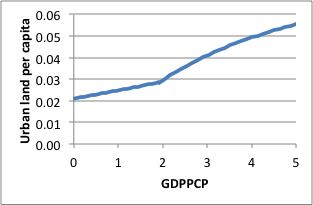International Futures Help System
Changes in Urban Land from Income and Population Changes
Changes in urban land result from changes in population and income. IFs first estimates a predicted level of urban land (LandUrbanPred), which is then compared to current urban land. Any changes are assumed to affect all other land types proportionately, unless this leads to not enough land in a particular category. The assumptions about the drivers of the predicted level of urban land differ somewhat between countries depending upon their state of development, as measured by average income, in the base year.
For initially not as well off countries, GDPPCP in the base year < 5, the predicted level of urban land (LandUrbanPred) is estimated as a function of population and income growth. The growth with income is based on an estimated relationship between income and urban land per capita (landurbanr) summarized in the figure below [1] .

The predicted level of urban land (LandUrbanPred) is then given as
![]()
For initially well off countries, GDPPCP in the base year > 5, the predicted level of urban land is estimated as a function of population change. If population increases from the base year, is assumed to be same as urban land in the base year. If population declines from the base year, the predicted urban land area is estimated to decline, but only half as much as the population decline

The change in urban land (NUrbLD) is then calculated as
![]()
Limits are placed on the change in urban land area. First, if urban land is growing, the amount of increase in a single year cannot exceed 1/100th of a variable that is related to the change in the non-urban share of all other land from the base year (NonUrbanShrR)
![]()
where
![]()
Second, if urban land is declining, it is not permitted to fall below 10,000 hectares. Third, the changes are assumed to affect all other land categories proportionately.
![]()
However, this is not allowed to result in the area for a given land category falling below 1,000 hectares. Thus, there may be a slight reduction in the amount of new urban land in certain cases.
[1] Equation is Urban land per Capita = 0.021 + 0.0039*GDPPCP when GDPPCP < 1.92 in the base year and Urban land per Capita = 0.01 + 0.0283*ln(GDPPCP) when GDPPCP >= 1.92 in the base year.
 International Futures at the Pardee Center
International Futures at the Pardee Center